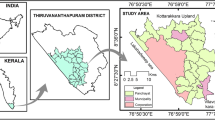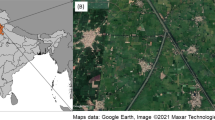Abstract
Context
Urbanization is the most important form of landscape change and is increasingly affecting biodiversity and ecosystem functions. Understanding how landscape patterns change in space and time is central to the evaluation of the environmental impacts of urbanization.
Objectives
This research explores the spatiotemporal patterns of land use change in the Swiss urban agglomerations of Bern, Lausanne and Zurich at two characteristic spatial extents, and compares them to prominent hypotheses of urbanization patterns.
Methods
For each urban agglomeration, four temporal snapshots from 1980 to 2016 have been derived from the land use inventory of the Swiss Federal Statistical Office. Fractal analysis of the area–radius relationship of urban land is used to separate each agglomeration into two characteristic spatial extents according to the distance of the city center, namely the inner and outer zones. The landscape metrics and growth modes are then computed at such extents.
Results
The time series of landscape metrics and growth modes reveal fairly different patterns when computed in the inner and outer zones respectively. Bern and Lausanne exhibit mostly traits of coalescence stages at the inner zone while displaying many characteristics of diffusion in the outer zone. In contrast, the trends of observed in the inner and outer zones of Zurich are both reminiscent of a coalescence stages.
Conclusions
Fractal analysis can be a useful approach to detect characteristic extents of urban agglomerations at which distinct spatiotemporal patterns might be observed. Current models of urbanization patterns should incorporate the notion of characteristic extents more explicitly.
Similar content being viewed by others
Notes
The exact dates of each surveying period 1979/85, 1992/97, 2004/09 and 2013/18 are determined according to the production process of the national maps and vary accross the Swiss territory (SFSO 2017).
References
Alberti M (2005) The effects of urban patterns on ecosystem function. Int Reg Sci Rev 28(2):168–192
Angel S, Sheppard S, Civco DL, Buckley R, Chabaeva A, Gitlin L, Kraley A, Parent J, Perlin M (2005) The dynamics of global urban expansion. Citeseer
Batty M (2005) Cities and complexity: understanding cities with cellular automata, agent-based models, and fractals. MIT Press, Cambridge
Batty M (2008) The size, scale, and shape of cities. Science 319(5864):769–771
Batty M, Longley P (1994) Fractal cities: a geometry of form and function. Academic Press, San Diego
Bosch M (2019a) Pylandstats: an open-source pythonic library to compute landscape metrics. PLoS ONE 14(12):e0225734
Bosch M (2019b) swisslandstats-geopy: Python tools for preprocessing geodata from the swiss federal statistical office. J Open Source Softw 4(40):1511
Dietzel C, Herold M, Hemphill JJ, Clarke KC (2005) Spatio-temporal dynamics in California’s central valley: empirical links to urban theory. Int J Geogr Inf Sci 19(2):175–195
Frankhauser P (1994) La fractalité des structures urbaines. Anthropos, Paris
Grimm NB, Faeth SH, Golubiewski NE, Redman CL, Wu J, Bai X, Briggs JM (2008) Global change and the ecology of cities. Science 319(5864):756–760
Jaeger JA, Schwick C (2014) Improving the measurement of urban sprawl: weighted urban proliferation (WUP) and its application to Switzerland. Ecol Ind 38:294–308
Jenerette GD, Potere D (2010) Global analysis and simulation of land-use change associated with urbanization. Landsc Ecol 25(5):657–670
Li C, Li J, Wu J (2013) Quantifying the speed, growth modes, and landscape pattern changes of urbanization: a hierarchical patch dynamics approach. Landsc Ecol 28(10):1875–1888
Liu Z, He C, Wu J (2016) General spatiotemporal patterns of urbanization: an examination of 16 world cities. Sustainability 8(1):41
Liu X, Li X, Chen Y, Tan Z, Li S, Ai B (2010) A new landscape index for quantifying urban expansion using multi-temporal remotely sensed data. Landsc Ecol 25(5):671–682
Mandelbrot BB (1983) The fractal geometry of nature, vol 173. W.H. Freeman, New York
McGarigal K, Cushman SA, Ene E (2012) Fragstats v4: spatial pattern analysis program for categorical and continuous maps. Computer software program produced by the authors at the University of Massachusetts, Amherst. http://www.umass.edu/landeco/research/fragstats/fragstats.html. Accessed 5 Mar 2020
Nong DH, Lepczyk CA, Miura T, Fox JM (2018) Quantifying urban growth patterns in hanoi using landscape expansion modes and time series spatial metrics. PLoS ONE 13(5):e0196940
Price B, Kienast F, Seidl I, Ginzler C, Verburg PH, Bolliger J (2015) Future landscapes of switzerland: risk areas for urbanisation and land abandonment. Appl Geogr 57:32–41
Riitters KH, O’neill R, Hunsaker C, Wickham JD, Yankee D, Timmins S, Jones K, Jackson B (1995) A factor analysis of landscape pattern and structure metrics. Landsc Ecol 10(1):23–39
Rozenfeld HD, Rybski D, Andrade JS, Batty M, Stanley HE, Makse HA (2008) Laws of population growth. Proc Natl Acad Sci 105(48):18702–18707
Schneider A, Woodcock CE (2008) Compact, dispersed, fragmented, extensive? A comparison of urban growth in twenty-five global cities using remotely sensed data, pattern metrics and census information. Urban Stud 45(3):659–692
Seto KC, Fragkias M (2005) Quantifying spatiotemporal patterns of urban land-use change in four cities of china with time series landscape metrics. Landsc Ecol 20(7):871–888
Storn R, Price K (1997) Differential evolution—a simple and efficient heuristic for global optimization over continuous spaces. J Glob Optim 11(4):341–359
Swiss Federal Statistical Office (2014) L’espace à caractère urbain en suisse en 2012: Une nouvelle définition des agglomérations et d’autres catégories d’espace urbain. https://www.bfs.admin.ch/bfs/fr/home/statistiques/themes-transversaux/analyses-spatiales/niveaux-geographiques.assetdetail.349554.html. Accessed 17 Apr 2019
Swiss Federal Statistical Office (2017) Statistique de la superficie selon nomenclature 2004—standard. https://www.bfs.admin.ch/bfs/fr/home/services/geostat/geodonnees-statistique-federale/sol-utilisation-couverture/statistique-suisse-superficie/nomenclature-standard.assetdetail.4103540.html (in French). Accessed 18 Apr 2019
Swiss Federal Statistical Office (2018) City statistics (urban audit). Data collection. https://www.bfs.admin.ch/bfs/en/home/statistics/cross-sectional-topics/city-statistics.html. Accessed 16 Apr 2019
Tannier C, Thomas I (2013) Defining and characterizing urban boundaries: a fractal analysis of theoretical cities and Belgian cities. Comput Environ Urban Syst 41:234–248
White R, Engelen G (1993) Cellular automata and fractal urban form: a cellular modelling approach to the evolution of urban land-use patterns. Environ Plan A 25(8):1175–1199
White R, Engelen G, Uljee I (2015) Modeling cities and regions as complex systems: from theory to planning applications. MIT Press, Cambridge
Wu J (2004) Effects of changing scale on landscape pattern analysis: scaling relations. Landsc Ecol 19(2):125–138
Wu J (2014) Urban ecology and sustainability: the state-of-the-science and future directions. Landsc Urban Plan 125:209–221
Wu J, Jenerette GD, Buyantuyev A, Redman CL (2011) Quantifying spatiotemporal patterns of urbanization: the case of the two fastest growing metropolitan regions in the United States. Ecol Complex 8(1):1–8
Wu J, Shen W, Sun W, Tueller PT (2002) Empirical patterns of the effects of changing scale on landscape metrics. Landsc Ecol 17(8):761–782
Acknowledgements
This research has been supported by the École Polytechnique Fédérale de Lausanne (EPFL).
Author information
Authors and Affiliations
Corresponding author
Additional information
Publisher's Note
Springer Nature remains neutral with regard to jurisdictional claims in published maps and institutional affiliations.
Rights and permissions
About this article
Cite this article
Bosch, M., Jaligot, R. & Chenal, J. Spatiotemporal patterns of urbanization in three Swiss urban agglomerations: insights from landscape metrics, growth modes and fractal analysis. Landscape Ecol 35, 879–891 (2020). https://doi.org/10.1007/s10980-020-00985-y
Received:
Accepted:
Published:
Issue Date:
DOI: https://doi.org/10.1007/s10980-020-00985-y









